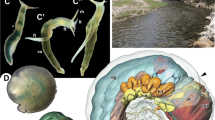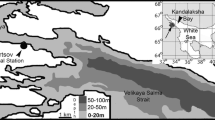Abstract
Various cnidarians have adapted their life style to interstitial habitats of marine sediments. Recently, for the first time a hydroid was reported from the interstitial brine channel system of Arctic fast ice. Due to its derived features, the new genus and species Sympagohydra tuuli was introduced. Here we describe findings of S. tuuli in sea ice at several sites within the central Arctic Ocean. In our view the results of this study do not allow assignment of Sympagohydra to any known family and we, therefore, suggest the introduction of a new family Sympagohydridae which is placed within the hydrozoan subclass Hydroidolina, order Anthomedusae, suborder Capitata. A first detailed histological analysis of S. tuuli is presented. In vivo analysis of locomotion and reproduction revealed a remarkable convergent evolution in S. tuuli and distant meiobenthic relatives. Shared traits are a flagellated epidermis enabling the animals to glide within small interstices by means of flagellar beating as well as an internalised embryogenesis. In S. tuuli gametogenesis occurs in the absence of gonophores inbetween gastro- and epidermis clearly separated from the epidermis. Budding was observed as the vegetative mode of reproduction. Documentation of feeding behaviour identified copepod nauplii and rotifers as prey items and demonstrates a high trophical position of the hydroids within the sympagic food web. Occurrence of reproducing individuals and pronounced tolerances towards changing temperatures and salinities indicate S.tuuli as a truly sympagic species.









Similar content being viewed by others
References
Arrigo KR, Thomas DN (2004) Large scale importance of sea ice biology in the Southern Ocean. Antarct Sci 16(4):471–486. doi:https://doi.org/10.1017/S0954102004002263
Bluhm BA, Gradinger R, Piraino S (2007) First record of sympagic hydroids (Hydrozoa, Cnidaria) in Arctic coastal fast ice. Polar Biol 30:1157–1563. doi:https://doi.org/10.1007/s00300-007-0316-9
Bouillon J, Medel MD, Pages F, Gili JM, Boero B, Gravili C (2004) Fauna of the Mediterranean Hydrozoa. Sci Mar Barc 68(Suppl. 2):1–448
Cartwright P, Evans NM, Dunn CW, Marques AC, Miglietta MP, Schuchert P, Collins AG (2008) Phylogenetics of Hydroidolina (Hydrozoa: Cnidaria). J Mar Biol Assoc UK. doi:https://doi.org/10.1017/S0025315408002257
Collins AG, Bentlage B, Lindner A, Lindsay D, Haddock SHD, Jarms G, Norenburg JL, Jankowski T, Cartwright P (2008) Phylogenetics of Trachylina (Cnidaria: Hydrozoa) with new insights on the evolution of some problematical taxa. J Mar Biol Assoc UK. doi:https://doi.org/10.1017/S0025315408001732
Collins AG, Schuchert P, Marques AC, Jankowski T, Medina M, Schierwater B (2006) Medusozoan phylogeny and character evolution clarified by new large and small subunit rDNA data and an assessment of the utility of phylogenetic mixture models. Syst Biol 55:97–115. doi:https://doi.org/10.1080/10635150500433615
Cunningham CW, Buss LW (1993) Molecular evidence for multiple episodes of paedomorphosis in the family Hydractiniidae. Biochem Syst Ecol 21:57–69. doi:https://doi.org/10.1016/0305-1978(93)90009-G
Folmer O, Black M, Hoen W, Lutz R, Vrijenhoek R (1994) DNA primers for amplification of mitochondrial cytochrome c oxidase subunit I from diverse metazoan invertebrates. Mol Mar Biol Biotechnol 3:294–299
Garrison DL, Buck KR (1986) Organism losses during ice melting: a serious bias in sea ice community studies. Polar Biol 6(4):237–239. doi:https://doi.org/10.1007/BF00443401
Giere O (1993) Meiobenthology: the microscopic fauna in aquatic sediments. Springer, Berlin
Gradinger R (1999) Integrated abundance and biomass of sympagic meiofauna in Arctic and Antarctic pack ice. Polar Biol 22(3):169–177. doi:https://doi.org/10.1007/s003000050407
Gradinger R, Meiners K, Plumley G, Zhang Q, Bluhm BA (2005) Abundance and composition of the sea-ice meiofauna in off-shore pack ice of the Beaufort Gyre in summer 2002 and 2003. Polar Biol 28(3):171–181. doi:https://doi.org/10.1007/s00300-004-0674-5
Grainger EH, Hsiao SIC (1990) Trophic relationships of the sea ice meiofauna in Frobisher Bay, Arctic Canada. Polar Biol 10(4):283–292. doi:https://doi.org/10.1007/BF00238427
Heip C, Smol N (1976) On the importance of Protohydra leuckarti as a predator of meiobenthic populations. In: Persoone G, Jaspers E (eds) Proceedings of the 10th European marine biology symposium, vol 2, Population dynamics of marine organisms in relation with nutrient cycling in shallow waters. Universa Press, Wetteren, pp 285–296
Hemmrich G, Anokhin B, Zacharias H, Bosch TCG (2007) Molecular phylogenetics in Hydra, a classical model in evolutionary developmental biology. Mol Phylogenet Evol 44(1):281–290. doi:https://doi.org/10.1016/j.ympev.2006.10.031
Hoshiai T, Tanimura A, Watanabe K (1987) Ice algae as food of an Antarctic ice-associated copepod, Paralabidocera antarctica (I. C. Thompson). Proc NIPR Symp Polar Biol 1:105–111
Kiko R, Kramer M, Spindler M, Wägele H (2008) Tergipes antarcticus (Gastropoda, Nudibranchia): distribution, life cycle, morphology, anatomy and adaptation of the first mollusc known to live in Antarctic sea ice. Polar Biol. doi:https://doi.org/10.1007/s00300-008-0478-0
Marques AC, Collins AG (2004) Cladistic analysis of Medusozoa and cnidarian evolution. Invertebr Biol 123:23–42
Petersen KW (1990) Evolution and taxonomy in capitate hydroids and medusae (Cnidaria: Hydrozoa). Zool J Linn Soc-Lond 100:101–231. doi:https://doi.org/10.1111/j.1096-3642.1990.tb01862.x
Piraino S, Bluhm BA, Gradinger R, Boero F (2008) Sympagohydra tuuli gen. nov. and sp. nov. (Cnidaria: Hydrozoa) a cool hydroid form the Arctic sea ice. J Mar Biol Assoc UK. doi:https://doi.org/10.1017/S0025315408002166
Posada D, Crandall KA (1998) Modeltest: testing the model of DNA substitution. Bioinformatics 14(9):817–818. doi:https://doi.org/10.1093/bioinformatics/14.9.817
Remane A (1927) Halammohydra, ein eigenartiges Hydrozoon der Nord- und Ostsee. Z Morph U Ökol Tiere 7:643–677
Reynolds AS (1963) The use of lead citrate at high pH as an electron-opaque stain in electron microscopy. J Cell Biol 17:208–212. doi:https://doi.org/10.1083/jcb.17.1.208
Richardson KC, Jarett L, Finke EH (1960) Embedding in epoxy resins for ultrathin sectioning in electron microscopy. Stain Technol 35:313–323
Salvini-Plawen vL (1966) Zur Kenntnis der Cnidaria des nordadriatischen Mesopsammon. In: VI. Meeresbiologisches Symposium. Veröffentlichungen des Instituts für Meeresforschung in Bremerhaven, Sonderband 2:165–186
Schnack-Schiel SB, Thomas D, Dieckmann GS, Eicken H, Gradinger R, Spindler M, Weissenberger J, Mizdalski E, Beyer K (1995) Life cycle strategy of the Antarctic calanoid copepod Stephos longipes. Prog Oceanogr 36(1):45–75. doi:https://doi.org/10.1016/0079-6611(95)00014-3
Schnack-Schiel SB (2003) The macrobiology of sea ice. In: Thomas DN, Diekmann GS (eds) Sea ice. Introduction to its physics, chemistry, biology and geology. Blackwell, Oxford, pp 211–239
Schnack-Schiel SB, Dieckmann GS, Kattner G, Thomas DN (2004) Copepods in summer platelet ice in the eastern Weddell Sea, Antarctica. Polar Biol 27(8):502–506. doi:https://doi.org/10.1007/s00300-004-0613-5
Schuchert P (2001) Hydroids of Greenland and Iceland (Cnidaria, Hydrozoa). Medd Gronl Biosci 53:1–184
Schuchert P (2006) The European athecate hydroids and their medusae (Hydrozoa, Cnidaria): Capitata. Part 1. Rev Suisse Zool 113:325–410
Schulz E (1950) Psammohydra nana, ein neues solitäres Hydrozoon in der westlichen Beltsee (Studien an Hydrozoa, II). Kiel Meeresforsch 7(2):122–137
Schulz E (1952) Ungeschlechtliche Fortpflanzung durch Knospung bei Protohydra leuckarti Greef (Studien an Hydrozoa, III). Kiel Meeresforsch 7:68–69
Schünemann H, Werner I (2005) Seasonal variations in the distribution patterns of sympagic metazoans in Arctic pack ice. Mar Biol (Berl) 146:1091–1102. doi:https://doi.org/10.1007/s00227-004-1511-7
Spreen G, Kaleschke L, Heygster G (2008) Sea ice remote sensing using AMSR-E 89-GHz channels. J Geophys Res 113:C02S03. doi:https://doi.org/10.1029/2005JC003384
Swedmark B, Teissier G (1958) Otohydra vagans n. g., n.sp., hydrozoaire des sables, apparanté aux Halammohydridées. C R Acad Sci Paris 247(2):238–240
Swedmark B, Teissier G (1959) Halammohydra et Otohydra, Hydrozoaires de la microfaune des sables et l’ordre des Actinulides. Proceedings XV Int Congr Zool, pp 330–331
Swedmark B (1964) The interstitial fauna of marine sand. Biol Rev Camb Philos Soc 39:1–42. doi:https://doi.org/10.1111/j.1469-185X.1964.tb00948.x
Swofford DL (1998) PAUP phylogenetic analysis using parsimony (and other methods). Sinauer, Sunderland
Thomas MB, Edwards NC, Higgins RP (1995) Cryptohydra thieli n. gen., n. sp.: a meiofaunal marine hydroid (Hydroida, Athecata, Capitata). Invertebr Biol 114:107–118. doi:https://doi.org/10.2307/3226883
Weissenberger J, Dieckmann G, Gradinger R, Spindler M (1992) Sea ice: a cast technique to examine and analyze brine pockets and channel structure. Limnol Oceanogr 37:179–183
Werner I (2006) Seasonal dynamics, cryo-pelagic interactions and metabolic rates of Arctic pack-ice and under-ice fauna: a review. Polarforschung 75(1):1–19
Westblad E (1935) Neue Beobachtungen über Protohydra. Zool Anz 111:152–158
Westblad E (1937) Boreohydra simplex n. gen., n. sp., ein Solitärpolyp von der norwegischen Küste. Arkiv Zool 29:1–6
Zwickl DJ (2006) Genetic algorithm approaches for the phylogenetic analysis of large biological sequence datasets under the maximum likelihood criterion. Ph.D. dissertation, The University of Texas at Austin
Acknowledgments
We thank Thomas C.G. Bosch for providing excellent laboratory facilities and him and Iris Werner for generous support. Furthermore we thank both for critically reading and improving the manuscript. We also thank Peter Schuchert for comments on the manuscript, discussion and helpful advises, Boris Anokhin for discussion, help with nematocyst analysis and the stenotele drawing, Antje Thomas for help with histology, Stefano Piraino for sharing unpublished data, Alice Schneider for help in the field, Gunnar Spreen for providing the map of sampling sites, Kristina Barz for sharing digital devices, the captain and crew of RV “Polarstern” for professional support, Sebastian Fraune for help with molecular phylogenetic analysis, Dirk Brandis and Sievert Lorenzen for useful comments. This work was supported, in part, by grants to Iris Werner from the Deutsche Forschungsgemeinschaft (WE 2536/11-1).
Author information
Authors and Affiliations
Corresponding author
Additional information
Communicated by U. Sommer.
Electronic supplementary material
Below is the link to the electronic supplementary material.
Supplement S1.
Phylogenetic hypothesis among 112 hydrozoan taxa using themaximum likelihood criterion on a concatenated dataset comprising partial 16S, 18Sand 28S ribosomal sequence information. Bootstrap values greater than 50 areindicated. Estimated parameters of the assumed model GTR+I+G were: A-C, 0.8877; AG,2.9294; A-T, 1.6218, C-G, 0.8694; C-T, 5.2844; G-T, 1.0000; assumed proportion ofinvariant sites: 0.5775, gamma shaped parameter 0.6086. (6.96 MB)
Supplement S2.
File containing the data matrix used in the phylogenetic analysis and consensus tree of the ML analysis. (TXT 830 kb)
V1. Bending of proboscis-like hypostome. Two tentacles are visible. Gastrodermal cells contain vacuoles with reddish prey pigment. (WMV 4911 kb)
V2. Locomotion of Sympagohydra tuuli. Beating flagella on epidermal cells of the body column. (WMV 7177 kb)
V3. Locomotion of Sympagohydra tuuli. Beating flagella facilitate gliding movement. Tentacles can be seen at oral end of the animals. Beating mode and direction of gliding can be changed. (AVI 3012 kb)
V4. Locomotion of Sympagohydra tuuli. Animals rotate around their longitudinal axis when rising in the water column. (WMV 5255 kb)
Rights and permissions
About this article
Cite this article
Siebert, S., Anton-Erxleben, F., Kiko, R. et al. Sympagohydra tuuli (Cnidaria, Hydrozoa): first report from sea ice of the central Arctic Ocean and insights into histology, reproduction and locomotion. Mar Biol 156, 541–554 (2009). https://doi.org/10.1007/s00227-008-1106-9
Received:
Accepted:
Published:
Issue Date:
DOI: https://doi.org/10.1007/s00227-008-1106-9




